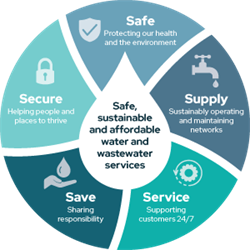The urban water cycle
Moving water through the Tweed’s urban areas
Water is a part of our everyday lives. We use it to shower, to brush our teeth, to wash the dishes and our clothes, to clean our cars, and to flush away our poos and pees.
It’s no wonder we don’t readily stop to think about where the water comes from and where it goes once we use it.
The water we use is old – very old. It’s always been present on the Earth.
Our planet recycles water through a process called the natural water cycle.
In cities and towns, we have what’s called the urban water cycle. It differs from the natural water cycle because people have changed the natural process, building dams, pipes, treatment plants, pump stations and more.
The urban water cycle outlines how people in cities and towns collect, store, supply, use, clean and treat water so it can safely return to nature.
Council manages the urban water cycle in the Tweed with the aim of providing safe, sustainable and affordable water and wastewater services – they’re the foundations of a healthy community.
To find out more, watch this short video - or read on below.
Where your water comes from
The Tweed’s tap water is sourced from the upper catchment areas of the Tweed and Rous Rivers, where grazing land and forests abound.
When it rains, water flows from these areas through creeks into Clarrie Hall Dam, and the Tweed and Rous Rivers.
Water is stored in the dam and released when the water level of the Tweed River falls due to drier weather.
Council extracts water from the rivers, treats it to ensure it’s safe, and then pumps the treated water to homes and businesses through a vast network of storage reservoirs and underground pipes.
Some homes and businesses aren’t connected to Council’s water network. These premises collect their own drinking water via rainwater tanks and rely on top ups from the Tweed water network during drier weather.
Where your dirty water goes
The water we dispose of is called wastewater.
Council removes and cleans wastewater though another network of pipes, pumps and treatment plants. This is known as the wastewater network.
At the treatment plants, wastewater is cleaned and treated to a very high quality and is either recycled or released back into the environment.
Some recycled water is used for irrigating parks, sports fields and golf courses. It’s also used by industry such as the co-generation plant at Condong.
Some homes and businesses aren’t connected to Council’s wastewater network. These premises have their own on-site wastewater treatment systems.
